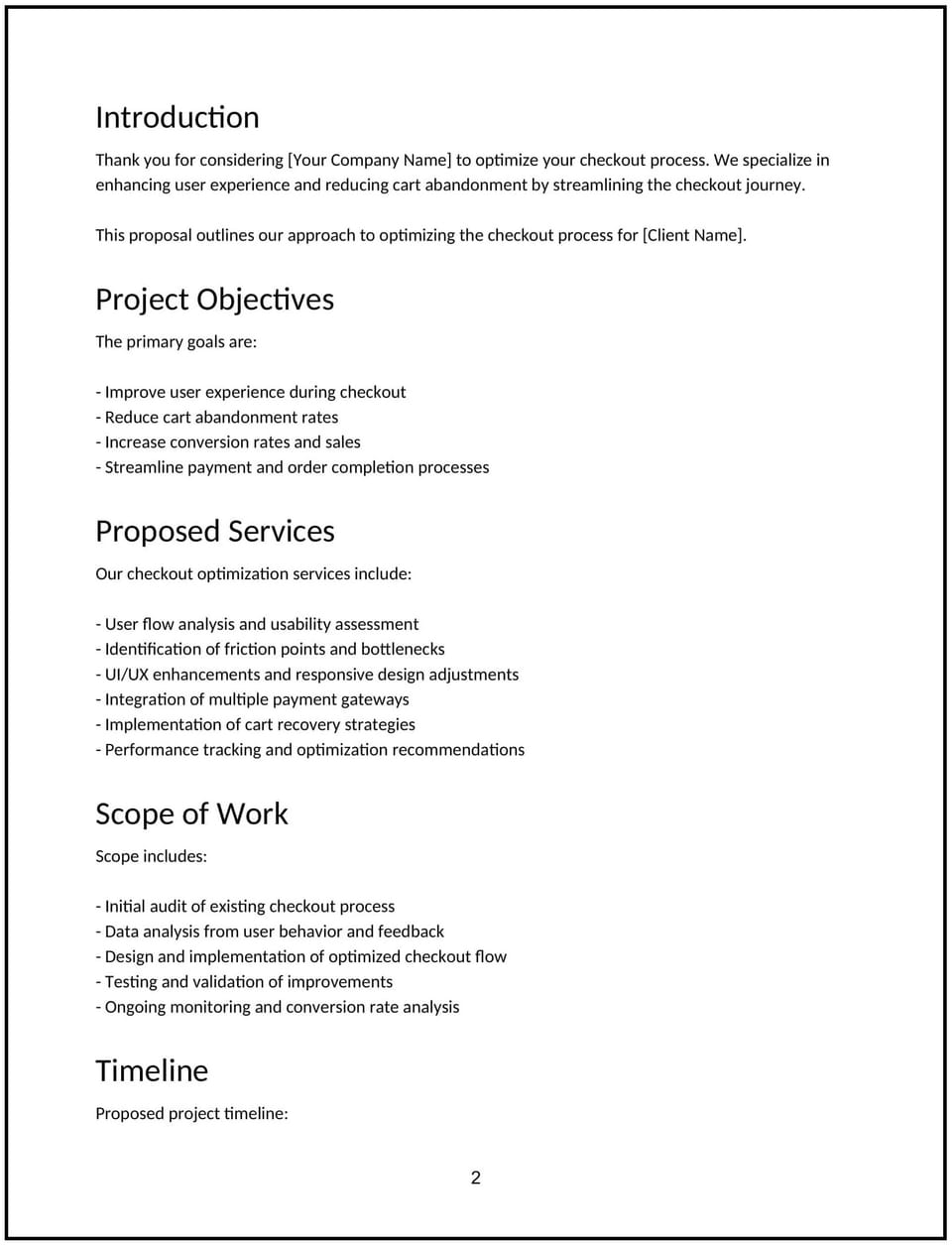Checkout process optimization proposal: Free template

Customize this free checkout process optimization proposal with Cobrief
Open this free checkout process optimization proposal in Cobrief and start editing it instantly using AI. You can adjust the tone, structure, and content based on your client’s business goals, current checkout flow, and friction points. You can also use AI to review your draft — spot gaps, tighten language, and improve clarity before sending.
Once you're done, send, download, or save the proposal in one click — no formatting or setup required.
This template is fully customizable and built for real-world use — ideal for pitching conversion audits, full checkout redesigns, or optimization sprints. Whether you’re working with DTC brands, SaaS platforms, or marketplaces, this version gives you a structured head start and removes the guesswork.
What is a checkout process optimization proposal?
A checkout process optimization proposal outlines how you plan to identify and remove friction points in a client’s purchase or signup flow. It often includes a review of their current UX, analytics insights, prioritized recommendations, and specific implementation tactics to improve conversion rates.
This type of proposal is typically sent:
- After an initial audit or performance review
- As a standalone offer or part of a broader CRO or UX engagement
- In response to revenue drop-offs, cart abandonment, or mobile checkout issues
It’s designed to turn lost opportunities into revenue by simplifying and accelerating the path to purchase.
An effective proposal helps you:
- Translate UX or analytics findings into actionable upgrades
- Build a clear case for the revenue upside of optimization work
- Show clients how you'll balance performance with design and tech feasibility
- Set the stage for collaboration across product, design, and engineering teams
Why use Cobrief to edit your proposal
With Cobrief, you can edit this proposal directly in your browser and refine it with built-in AI — no formatting or setup required.
- Edit the proposal directly in your browser: Start instantly without uploading or reformatting.
- Rewrite sections with AI: Improve clarity, remove jargon, or tailor messaging based on the client’s business type.
- Run a one-click AI review: Catch weak language, vague claims, or missed opportunities for clarity.
- Apply AI suggestions instantly: Accept edits line by line or apply all improvements in one go.
- Share or export instantly: Send your proposal directly or download a clean, client-ready version in PDF or DOCX.
It’s a faster, smarter way to get your proposal over the line.
When to use this proposal
Use this checkout process optimization proposal when:
- Proposing a UX audit and redesign of an underperforming checkout or signup flow
- Pitching a high-leverage optimization sprint to reduce cart abandonment
- Responding to a client with a sudden drop in checkout conversion
- Pairing with broader performance marketing or funnel work
- Scoping a fixed-fee engagement to improve checkout speed, trust, or accessibility
This is especially useful when working with clients who already have traffic but are leaking revenue at the point of purchase.
What to include in a checkout process optimization proposal
This template gives you a framework to communicate both the problem and the path to fixing it. Walk the client through your thinking, step by step.
- Executive summary: Outline the core problem (e.g., cart abandonment, form friction, mobile drop-off) and how your process will address it.
- Objectives and success metrics: Define what success looks like — e.g., reducing time-to-checkout, improving completion rate, or increasing average order value.
- Scope of work: Detail the work involved — user testing, analytics review, flow mapping, wireframes, tech recommendations, or A/B tests.
- Timeline and phases: Break the project into manageable chunks — audit, design, implementation, testing. Include estimated durations.
- Pricing: Show either a flat fee, phased approach, or day-rate depending on the engagement style. Be clear about what’s included.
- Technical collaboration: Highlight how you'll work with the client's dev team or platform constraints (e.g., Shopify, custom stack).
- Next steps: End with a single, clear CTA — usually a request to confirm, schedule a kickoff, or approve the scope.
How to write an effective checkout process optimization proposal
This kind of proposal needs to build trust, show clear ROI, and be easy to follow — especially for cross-functional teams.
- Speak to business outcomes: Focus on revenue impact, speed, and experience — not just UX theory.
- Back up your plan: Use client data, benchmarks, or prior project insights to justify your approach.
- Make it digestible: Keep sections short, structured, and scannable — clients are often reviewing this under time pressure.
- Anticipate stakeholder questions: Clarify dev involvement, platform constraints, or expected outcomes early.
- Balance detail with clarity: You don’t need to show every fix — just enough to show direction and confidence.
- Always close strong: Finish with a confident CTA and a timeline to act — this keeps momentum.
Frequently asked questions (FAQs)
Can I use this for both e-commerce and SaaS checkouts?
Yes — you can tailor the examples and metrics to suit either type of flow. Just update the scope and goals accordingly.
Does this proposal cover implementation work?
It can. You can frame it as strategy-only, implementation-only, or both — the template supports all formats.
Can I add heatmaps, recordings, or analytics findings?
Absolutely. You can include summaries in the body or link to full findings as an appendix or attachment.
Can I use this to pitch a short-term optimization sprint?
Yes — this template works well for 1–3 week engagements focused on specific KPIs or checkout stages.
Is this proposal legally binding?
No — this is a scope and pricing proposal. You can link or attach a contract or MSA if needed.
This article contains general legal information and does not contain legal advice. Cobrief is not a law firm or a substitute for an attorney or law firm. The law is complex and changes often. For legal advice, please ask a lawyer.